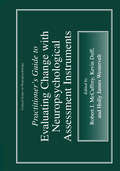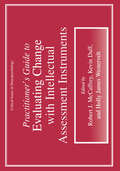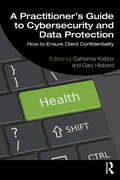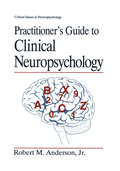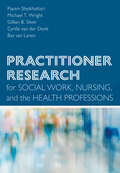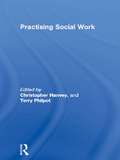- Table View
- List View
Practitioner’s Guide to Evaluating Change with Neuropsychological Assessment Instruments (Critical Issues in Neuropsychology)
by Robert J. McCaffrey Kevin Duff Holly James WesterveltThe impetus for this volume began with our research in the 1980's involving serial neuropsychological evaluation with various patient populations. At that time, reports on the practice effects associated with routinely utilized clinical neuropsychological instruments were sparse. While test-retest data were available for almost all assessment instruments, this was usually in the form of correlation coefficients and not changes in mean performance between or across assessment periods (see McCaffrey & Westervelt, 1995 for a detailed discussion of these and related issues). Clinical neuropsychological practitioners had few guidelines to assist them in determining if a change in a patient's performance across assessments was due to an intervention, maturation, practice effects, or a combination of factors. This volume represents our efforts at reviewing the literature between 1970 and 1998 and extracting the reported information on practice effects. The tables include the assessment instrument used, information on the subject/patient groups, the sample size (n}, gender, age, intervention, interval between the assessments, scores at both assessment points, and the citation. Those studies that reported data on more than two assessment points are indicated by a notation~ however, any data beyond the second assessment are not reported and the interested reader should refer to the original article. The tables are arranged alphabetically for the most widely used assessment instruments. Those instruments for which there was limited data on practice effects are grouped by "domain" (e. g.
Practitioner’s Guide to Evaluating Change with Intellectual Assessment Instruments (Critical Issues in Neuropsychology)
by Kevin DuffWhile conducting research on intellectual and neuropsychological perfonnance of various patient populations across time, we became aware of the lack of information concerning practice effects associated with many widely used assessment instruments. Although test-retest data were available for almost all of these instruments, it typically came in the form of correlation coefficients and mean changes in performance between assessments was often absent. In a 1995 article (McCaffrey & Westervelt, 1995), we discussed a number of issues relevant to serial neuropsychological and intellectual assessment and concluded that clinical neuropsychological practitioners had few guidelines to assist them in interpreting change in a patient's performance across assessments. This volume represents our efforts at reviewing the literature between 1970 and 1998 and extracting the reported information on practice effects. The tables include the assessment instrument used, information on the subject/patient groups, the sample size fu}, gender, age, intervention, interval between the assessments, scores at both assessment points, and the citation. The tables reflect the existing published literature within intellectual assessment and, therefore, some instruments (e.g., Wechsler tests) comprise a majority of the tables whereas others (e.g., Raven's Progressive Matrices, Stanford-Binet) do not. The test index is arranged by the name of the test as reported in the specific article. We caution readers to refer to the original articles if additional or more specific information is needed.
Practitioner's Guide to Ethics and Mindfulness-Based Interventions (Mindfulness in Behavioral Health)
by Lynette M. Monteiro Jane F. Compson Frank MustenThis book focuses on the role of ethics in the application of mindfulness-based interventions (MBIs) and mindfulness-based programs (MBPs) in clinical practice. The book offers an overview of the role of ethics in the cultivation of mindfulness and explores the way in which ethics have been embedded in the curriculum of MBIs and MBPs. Chapters review current training processes and examines the issues around incorporating ethics into MBIs and MBPs detailed for non-secular audiences, including training clinicians, developing program curriculum, and dealing with specific client populations. Chapters also examine new, second-generation MBIs and MBPs, the result of the call for more advanced mindfulness-based practices . The book addresses the increasing popularity of mindfulness in therapeutic interventions, but stresses that it remains a new treatment methodology and in order to achieve best practice status, mindfulness interventions must offer a clear understanding of their potential and limits.Topics featured in this book include:• Transparency in mindfulness programs.• Teaching ethics and mindfulness to physicians and healthcare professionals. • The Mindfulness-Based Symptom Management (MBSM) program and its use in treating mental health issues.• The efficacy and ethical considerations of teaching mindfulness in businesses. • The Mindful Self-Compassion (MSC) Program. • The application of mindfulness in the military context. Practitioner’s Guide to Mindfulness and Ethics is a must-have resource for clinical psychologists and affiliated medical, and mental health professionals, including specialists in complementary and alternative medicine and psychiatry. Social workers considering or already using mindfulness in practice will also find it highly useful.
Practitioner's Guide to Empirically-Based Measures of Depression (ABCT Clinical Assessment Series)
by Arthur M. NezuThis book is intended to guide clinicians and researchers in choosing practical tools relevant for clinical assessment, intervention, and/or research in this area. It contains over 90 reviews of measures of depression and depression-related constructs. It provides summary tables comparing and contrasting different instruments in terms of their time requirements, suitability, costs, administration, reliability, and validity, and sample copies of 25 instruments in the public domain.
Practitioner's Guide to Empirically Based Measures of Anxiety (ABCT Clinical Assessment Series)
by Martin M. Antony Susan M. Orsillo Lizabeth RoemerThis volume provides a single resource that contains information on almost all of the measures that have demonstrated usefulness in measuring the presence and severity of anxiety and related disorders. It includes reviews of more than 200 instruments for measuring anxiety-related constructs in adults. These measures are summarized in `quick view grids' which clinicians will find invaluable. Seventy-five of the most popular instruments are reprinted and a glossary of frequently used terms is provided.
Practitioner's Guide to Developmental and Psychological Testing (Critical Issues in Developmental and Behavioral Pediatrics)
by Glen P. AylwardThe practice of primary health care has expanded beyond the "traditional" medical model. Primary-care physicians and allied professionals are called upon more frequently to address parental concerns about develop mental delays, poor school performance, or behavioral problems. As a result, pediatricians, family practitioners, pediatric nurses, social workers, and speecManguage specialists are faced with the issue of developmental and psychological testing. The degree of the clinician's involvement in testing varies from interpretation of reports to performing screening or assessments. In many cases, the primary health care professional assumes the role of case manager. Unfortunately, cooperation between disciplines often has been lim ited because of poor communication, particularly in regard to develop mental and psychological testing, where acronyms, statistics, and jargon abound. Even professionals from mental health disciplines such as child psychiatrists or psychiatric social workers sometimes are overwhelmed. The purpose of this book, therefore, is to provide the clinician with practical information regarding developmental and psychological testing, thereby making the health care professional an "educated consumer. " This text does not simply describe how psychologists perform testing; rather, it provides information to help clinicians understand what the tests con tain, what their strengths and limitations are, and how they can be incorporated into practice.
A Practitioner’s Guide to Cybersecurity and Data Protection: How to Ensure Client Confidentiality
by Catherine Knibbs Gary HibberdA Practitioner’s Guide to Cybersecurity and Data Protection offers an accessible introduction and practical guidance on the crucial topic of cybersecurity for all those working with clients in the fields of psychology, neuropsychology, psychotherapy, and counselling. With expert insights, it provides essential information in an easy-to-understand way to help professionals ensure they are protecting their clients’ data and confidentiality, and protecting themselves and their patients from cyberattacks and information breaches, along with guidance on ethics, data protection, cybersecurity practice, privacy laws, child protection, and the rights and freedoms of the people the practitioners work with. Explaining online law, privacy, and information governance and data protection that goes beyond the GPDR, it covers key topics including: contracts and consent; setting up and managing safe spaces; children's data rights and freedoms; email and web security; and considerations for working with other organisations. Illustrated with examples from peer-reviewed research and practice, and with practical ‘top tips’ to help you implement the advice, this practical guide is a must-read for all working-from-home practitioners in clinical psychology, developmental psychology, neuropsychology, counselling, and hypnotherapy.
A Practitioner’s Guide to Cybersecurity and Data Protection: How to Ensure Client Confidentiality
A Practitioner’s Guide to Cybersecurity and Data Protection offers an accessible introduction and practical guidance on the crucial topic of cybersecurity for all those working with clients in the fields of psychology, neuropsychology, psychotherapy, and counselling. With expert insights, it provides essential information in an easy-to-understand way to help professionals ensure they are protecting their clients’ data and confidentiality, and protecting themselves and their patients from cyberattacks and information breaches, along with guidance on ethics, data protection, cybersecurity practice, privacy laws, child protection, and the rights and freedoms of the people the practitioners work with. Explaining online law, privacy, and information governance and data protection that goes beyond the GPDR, it covers key topics including: contracts and consent; setting up and managing safe spaces; children's data rights and freedoms; email and web security; and considerations for working with other organisations. Illustrated with examples from peer-reviewed research and practice, and with practical ‘top tips’ to help you implement the advice, this practical guide is a must-read for all working-from-home practitioners in clinical psychology, developmental psychology, neuropsychology, counselling, and hypnotherapy.
Practitioner’s Guide to Clinical Neuropsychology (Critical Issues in Neuropsychology)
by Robert M. Anderson Jr.Practitioner’s Guide to Behavioral Problems in Children
by Glen P. AylwardAn easy, concise reference with inclusion of practical diagnostic and treatment information Also appropriate for use by parents as a bibliotherapeutic aid Contains quick reference section of the 20 most frequently seen behavioral problems and what actions to take Written by a leading Pediatric Psychologist for use by not only Child Psychologists but also Pediatricians and Family Physicians
The Practitioner's Encyclopedia of Flower Remedies: The Definitive Guide to All Flower Essences, their Making and Uses
by Richard Gerber Clare G. Harvey George LewithThis comprehensive encyclopedia brings together flower essences gathered from all corners of the globe, from Hawaii and the Himalayas to America and the Australian Bush. It explains what flower remedies are, how they work and how to choose the right remedies for your clients' needs. The properties of 33 families of flower essences and the benefits of over 2,000 remedies, combinations, mists and creams are described. An easy-to-use ailment chart pinpoints remedies for a wide range of physical and psychological conditions, from stress to hormonal imbalance and from allergy to depression. The author provides instructions for prescribing, preparing and using flower remedies alongside illustrative patient case studies. This will be the definitive handbook for practitioners, therapists and students of complementary and alternative therapies working with flower essences and will be valuable reading for those wanting to learn more about how they can use flower essences in their practice.
The Practitioner's Encyclopedia of Flower Remedies: The Definitive Guide to All Flower Essences, their Making and Uses (PDF)
by Clare G. Harvey George Lewith Richard GerberThis comprehensive encyclopedia brings together flower essences gathered from all corners of the globe, from Hawaii and the Himalayas to America and the Australian Bush. It explains what flower remedies are, how they work and how to choose the right remedies for your clients' needs. The properties of 33 families of flower essences and the benefits of over 2,000 remedies, combinations, mists and creams are described. An easy-to-use ailment chart pinpoints remedies for a wide range of physical and psychological conditions, from stress to hormonal imbalance and from allergy to depression. The author provides instructions for prescribing, preparing and using flower remedies alongside illustrative patient case studies. This will be the definitive handbook for practitioners, therapists and students of complementary and alternative therapies working with flower essences and will be valuable reading for those wanting to learn more about how they can use flower essences in their practice.
Practitioners and Practices: A Conflict of Values?
by Julian Pratt Martin RowlandGeneral practice is the cornerstone of primary care in the UK. However, this traditional model has been challenged by new visions of its role, particularly a responsibility for improving health as well as for the care of illness, and a responsibility for populations as well as for individuals. This book focuses on the development of general practice as a framework within which community nurses and other professionals can build their contibution to the future of primary care. In so doing it shows how the care of general practice can be maintained and strengthened. This work is intended for all primary care staff, including doctors, nurses and managers, and for anyone interested in the future of primary care in the changing NHS.
Practitioners and Practices: A Conflict of Values?
by Julian Pratt Martin RowlandGeneral practice is the cornerstone of primary care in the UK. However, this traditional model has been challenged by new visions of its role, particularly a responsibility for improving health as well as for the care of illness, and a responsibility for populations as well as for individuals. This book focuses on the development of general practice as a framework within which community nurses and other professionals can build their contibution to the future of primary care. In so doing it shows how the care of general practice can be maintained and strengthened. This work is intended for all primary care staff, including doctors, nurses and managers, and for anyone interested in the future of primary care in the changing NHS.
Practitioner Research for Social Work, Nursing, and the Health Professions
by Michael T. Wright Payam Sheikhattari Gillian B. Silver Cyrilla van der Donk Bas van LanenAn invaluable tool for health and social work students and professionals who want to improve their practice through collaborative research with patients, clients, and colleagues.Throughout history, some of the most prominent contributors to health and social sciences have been men and women comfortable with both practice and academia. But today, research in health-related fields is increasingly conducted in specialized settings by people who are first and foremost researchers. Critics bemoan this loss of practice-based research, long considered a vital part of the contribution that doctors, nurses, public health workers, and social workers can make both to their field and the communities in which they work. Unfortunately, the explosion of new discoveries in health-related fields, along with the exponential increase in the amount of knowledge being produced and the growing demands of practice, have caused both the production and application of knowledge to become highly specialized and increasingly complex. This has resulted in a widening gap between research and practice.Recognizing the need for a guide to this type of research, Practitioner Research for Social Work, Nursing, and the Health Professions is a thoroughly reimagined version of a book originally published in 2011 in the Netherlands. Aimed at American practitioners, it is a highly practical guide for anyone in social work, nursing, and other health care and social welfare settings. Its seven-step Practitioner Research Method offers readers a tried-and-true approach to conducting research in their own work environments, and the authors use real-world examples to highlight strategies for overcoming barriers and incorporating research.While leading practitioners through each stage of the research process, the authors explain in detail how to apply a variety of field-tested tools and techniques. A unique and indispensable resource for students in undergraduate and graduate research courses, as well as for seasoned professionals who seek a practical guide for developing and implementing their own research projects in social work, nursing, and the health professions, this book is also the first textbook to introduce the concept and practice of practitioner research to an American audience.
Practitioner-based Research: Power, Discourse And Transformation (PDF)
by John Lees Dawn FreshwaterPractitioner-Based Research is concerned, in particular, with the research which is undertaken by healthcare practitioners and the evidence which they generate as a result of investigating their practice. In so doing it recognizes that, as well as working in academic life, practitioner researchers are often working as practitioners outside the Academy. It argues that the work of practitioner researchers has a significant contribution to make to healthcare research and so needs to be disseminated further in order to create balanced research communities within the healthcare professions. This book will help academic researchers to broaden the limited ontological and epistemological perspectives of their research. It will also encourage healthcare practitioners who have not been trained academically to develop their research skills and to realize that they are actually researching in their practice on a day-to-day basis. Finally, it will provide a degree of transparency about therapeutic processes to help clients and patients to see aspects of professional practice and development which are usually hidden from them.
Practitioner-based Research: Power, Discourse And Transformation
by John Lees Dawn FreshwaterPractitioner-Based Research is concerned, in particular, with the research which is undertaken by healthcare practitioners and the evidence which they generate as a result of investigating their practice. In so doing it recognizes that, as well as working in academic life, practitioner researchers are often working as practitioners outside the Academy. It argues that the work of practitioner researchers has a significant contribution to make to healthcare research and so needs to be disseminated further in order to create balanced research communities within the healthcare professions. This book will help academic researchers to broaden the limited ontological and epistemological perspectives of their research. It will also encourage healthcare practitioners who have not been trained academically to develop their research skills and to realize that they are actually researching in their practice on a day-to-day basis. Finally, it will provide a degree of transparency about therapeutic processes to help clients and patients to see aspects of professional practice and development which are usually hidden from them.
The Practitioner as Teacher - Updated Edition E-Book
by Brian Dolan Sue Hinchliff• Learning objectives begin each chapter • Sets teaching within the context of nursing and education • Aids the teaching of reflective practice • Activities and exercises reinforce learning • Cartoons illustrate significant points.This edition has been updated in the areas of: • The Knowledge and Skills Framework (part of Agenda for Change) • Competency-based practice • NVQs – National Vocational Qualifications• Re-registering with the NMC • Accreditation of Prior Experiential Learning (APEL).
The Practitioner as Teacher (PDF)
by Sue HinchliffDo you mentor student nurses and/or newly registered nurses? This is a trusted handbook on how to teach others: peers, students, patients and relatives. Using a 'talking through' strategy this is a practical 'How to' guide, rather than an academic treatise, with a much stronger focus on the use of competencies. Sections focus on these key areas: . How people learn . How to teach . How to use competencies in teaching . How to support learners . How to assess teaching & learning . Learning objectives begin each chapter . Sets teaching within the context of nursing and education . Aids the teaching of reflective practice . Activities and exercises reinforce learning . Cartoons illustrate significant points. This edition has been updated in the areas of: . The Knowledge and Skills Framework (part of Agenda for Change) . Competency-based practice . NVQs - National Vocational Qualifications . Re-registering with the NMC . Accreditation of Prior Experiential Learning (APEL). 9780702039546
Practising Social Work in a Complex World
This classic textbook provides the clearest and most authoritative introduction available to working in situations characterised not only by risk and change but also by high pressure to deliver successful outcomes. Edited by three of the leading names in Social Work, Robert Adams, Lena Dominelli and Malcolm Payne provide an indispensable guide to successful social work practise. Its coherent and thoughtful coverage of practice situations involving complexity, tension and uncertainty is uniquely geared to the needs of students in the final stages of their qualifying Social Work course, professionals returning to study, or those simply wishing to deepen their professional understanding.
Practising Social Work Ethics Around the World: Cases and Commentaries
by Sarah Banks Kirsten NøhrEthics is an increasingly important theme in social work practice. Worldwide, social workers experience common ethical challenges (how to be fair, whether to break a rule, how to act in politically tense situations) in very different contexts – from disaster relief in China to child protection work in Palestine. This book takes as its starting point real life cases featuring ethical problems in the areas of: negotiating roles and boundaries, respecting rights, being fair, challenging and developing organisations and working with policy and politics. Each case opens with a brief introduction, is followed by two commentaries and ends with questions for reflection. The commentaries, written by authors from different countries, refer to relevant theories, concepts, practical matters, alternative courses of action and their implications. Features within the book include: An introductory chapter covering issues of global ethics Cases and commentaries drawn from across the world – from Peru to Finland Cases based on real life situations and chapter introductions from leading authorities in social work and ethical theory Questions and practical exercises to aid teaching and professional development This book is a unique and accessible resource for stimulating ethical reflection, expanding ethical horizons and developing ethical and intercultural sensitivity. It is designed for use by undergraduate and postgraduate students and professionals in the fields of social work, social education/pedagogy, social care work, international social work, community development, community organisation, youth work and related fields.
Practising Social Work Ethics Around the World: Cases and Commentaries
by Sarah Banks Kirtsen NøhrEthics is an increasingly important theme in social work practice. Worldwide, social workers experience common ethical challenges (how to be fair, whether to break a rule, how to act in politically tense situations) in very different contexts – from disaster relief in China to child protection work in Palestine. This book takes as its starting point real life cases featuring ethical problems in the areas of: negotiating roles and boundaries, respecting rights, being fair, challenging and developing organisations and working with policy and politics. Each case opens with a brief introduction, is followed by two commentaries and ends with questions for reflection. The commentaries, written by authors from different countries, refer to relevant theories, concepts, practical matters, alternative courses of action and their implications. Features within the book include: An introductory chapter covering issues of global ethics Cases and commentaries drawn from across the world – from Peru to Finland Cases based on real life situations and chapter introductions from leading authorities in social work and ethical theory Questions and practical exercises to aid teaching and professional development This book is a unique and accessible resource for stimulating ethical reflection, expanding ethical horizons and developing ethical and intercultural sensitivity. It is designed for use by undergraduate and postgraduate students and professionals in the fields of social work, social education/pedagogy, social care work, international social work, community development, community organisation, youth work and related fields.
Practising Social Work
by Christopher Hanvey Terry PhilpotPracticing Social Workprovides a systematic exploratiuon of ar ange of social work approaches. Each chapter focuses on a single theme and explains the practice implications of a particular method.
Practising Social Work
by Christopher Hanvey Terry PhilpotPracticing Social Workprovides a systematic exploratiuon of ar ange of social work approaches. Each chapter focuses on a single theme and explains the practice implications of a particular method.
